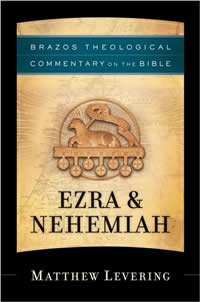Book Notes
 Matthew Levering, Ezra and Nehemiah; Brazos Theological Commentary on the Bible (Grand Rapids: Brazos Press, 2007), 236pp.
Matthew Levering, Ezra and Nehemiah; Brazos Theological Commentary on the Bible (Grand Rapids: Brazos Press, 2007), 236pp.
Levering's is the fourth installment in Brazos's projected forty-volume series of theological commentaries on the Bible. Jaroslav Pelikan led the series with a masterful study of the book of Acts (2005), Peter Leithart studied 1-2 Kings (2006), and Stanley Hauerwas of Duke University tackled the gospel of Matthew (2007). Levering's commentary stands or falls on his three working assumptions.
First, he takes as a "template" the idea of "holy people and holy land" from a previous work of his published in 2005. It's obvious that Ezra and Nehemiah treat of Israel's post-exilic return to the land, the rebuilding of the temple, and the restoration of liturgical life under the Torah. But if you are unfamiliar with or take exception to this "template," then the commentary will disappoint. Second, Levering reads Ezra and Nehemiah in light of other canonical books, which left me feeling like the books had little meaning or significance of their own for readers back then or now. Passages that speak of the exiles observing the passover, for example, evoke John 1:29 that Jesus is the passover lamb. References to the rebuilding of the walls elicit cross-references to Christ the foundation (1 Corinthians 3:11) and corner-stone (1 Peter 2:7). The walls of Nehemiah draw comparisons to a theology of the church. With the renewal of the covenant in Nehemiah 10 he draws an extended "connection" with the Lord's Prayer (pp. 191–194). Whether consciously or not, these spiritualized comparisons seem to follow the mystical commentary of the Venerable Bede of the eighth century, which might be Levering's single most-quoted source. He's surely right that his way of reading Scripture "gives the commentary the flavor of a pastiche of biblical quotations." Levering reads the Bible like this because of a third assumption about the nature of human history. In his view history is not merely "the linear progression of time" but "the non-chronological relationships through which past, present, and future human beings share in different ways the same realities." This complex "unity" of past, present and future, he admits, is a view that "escapes the historian's tools" but to which the theologian is somehow privy. On all three counts I remain unconvinced.


